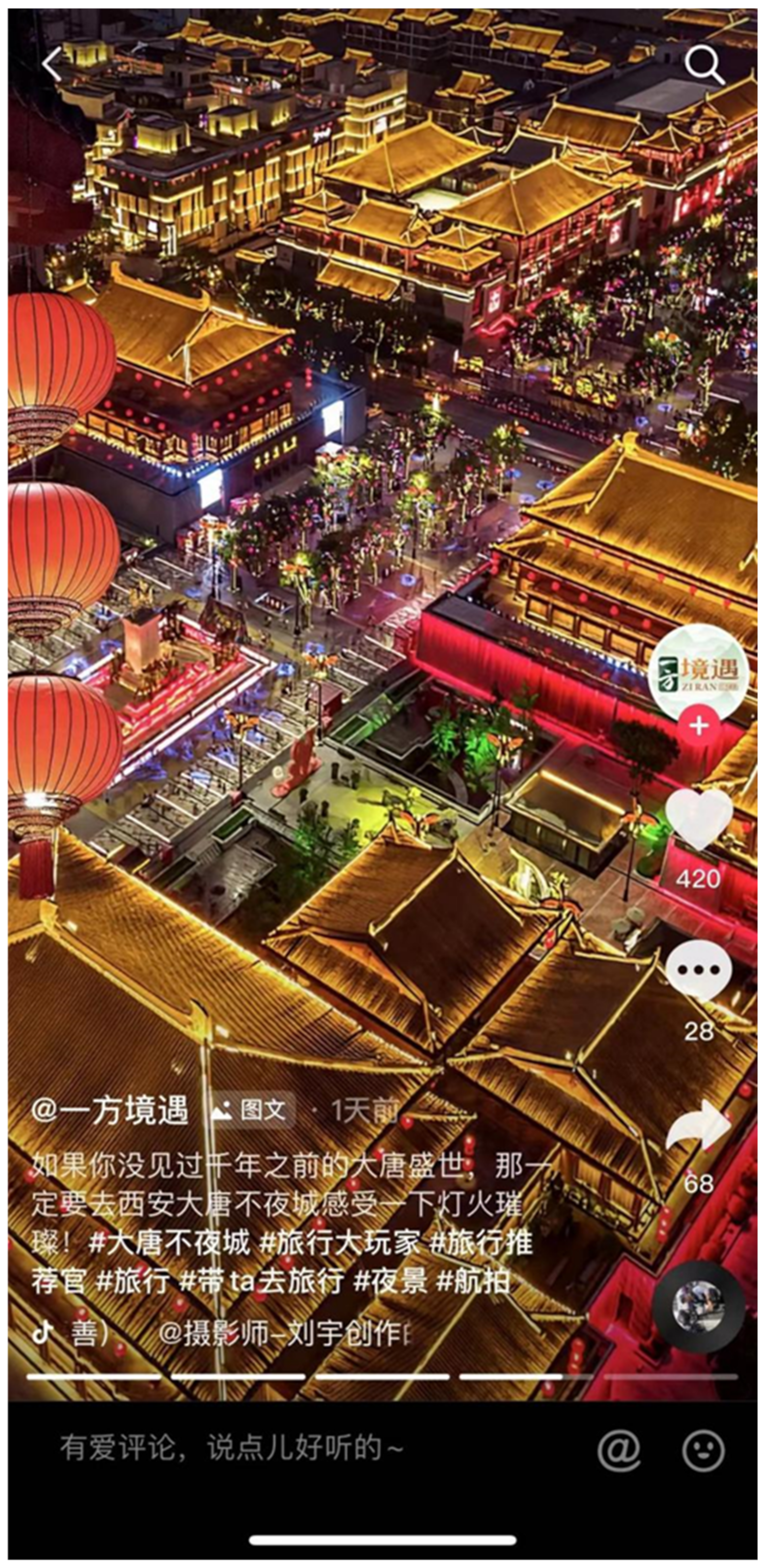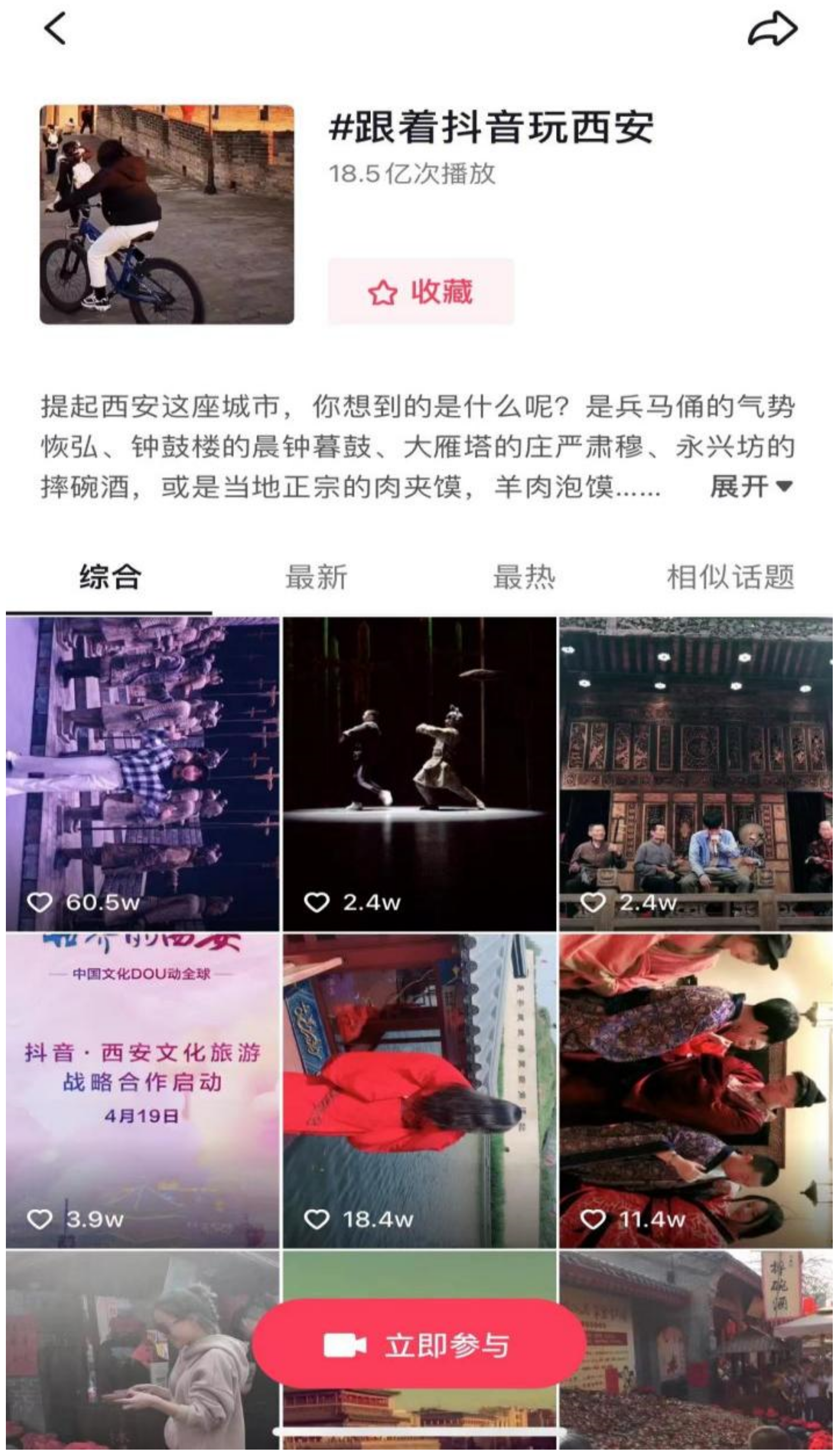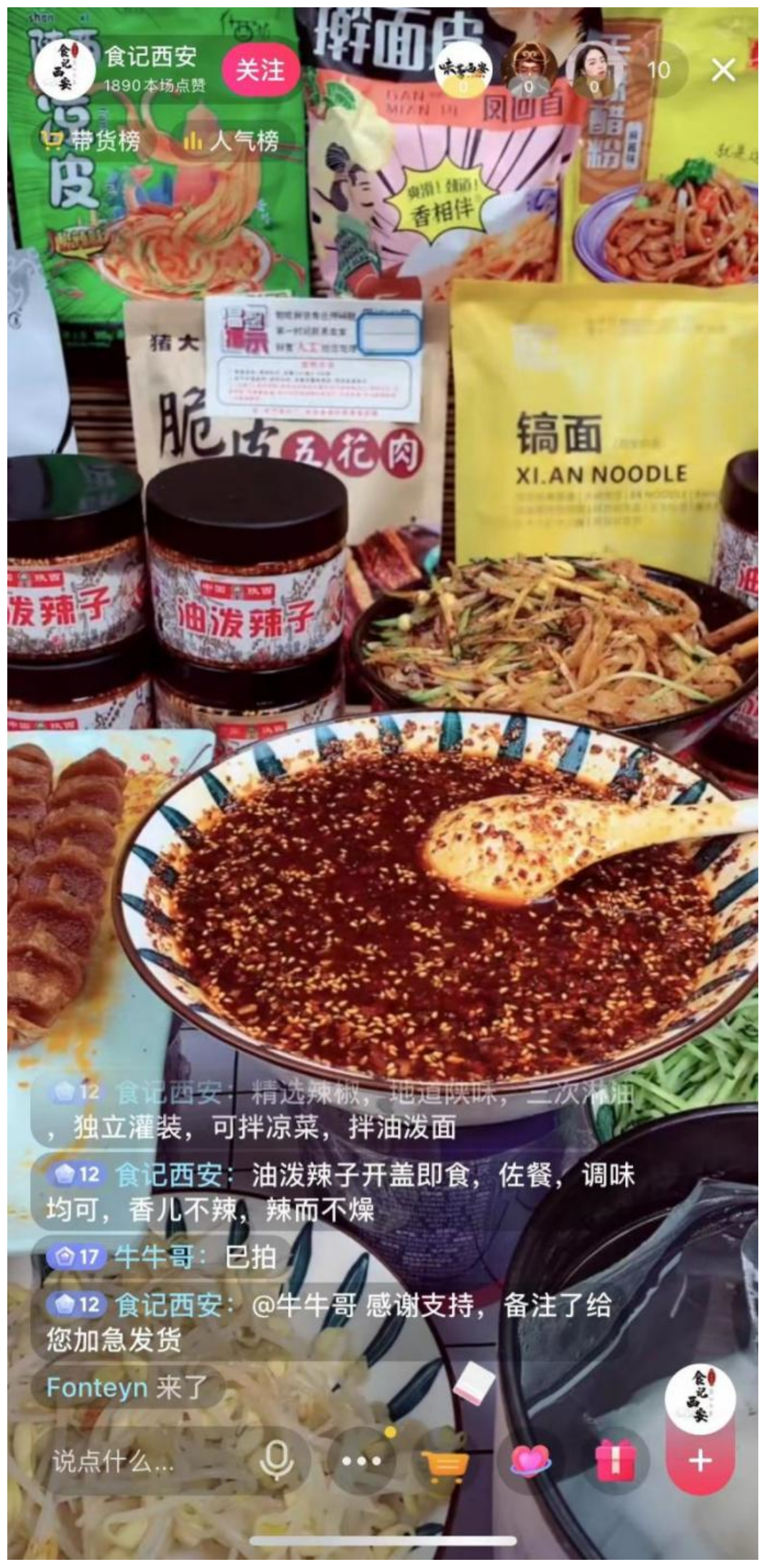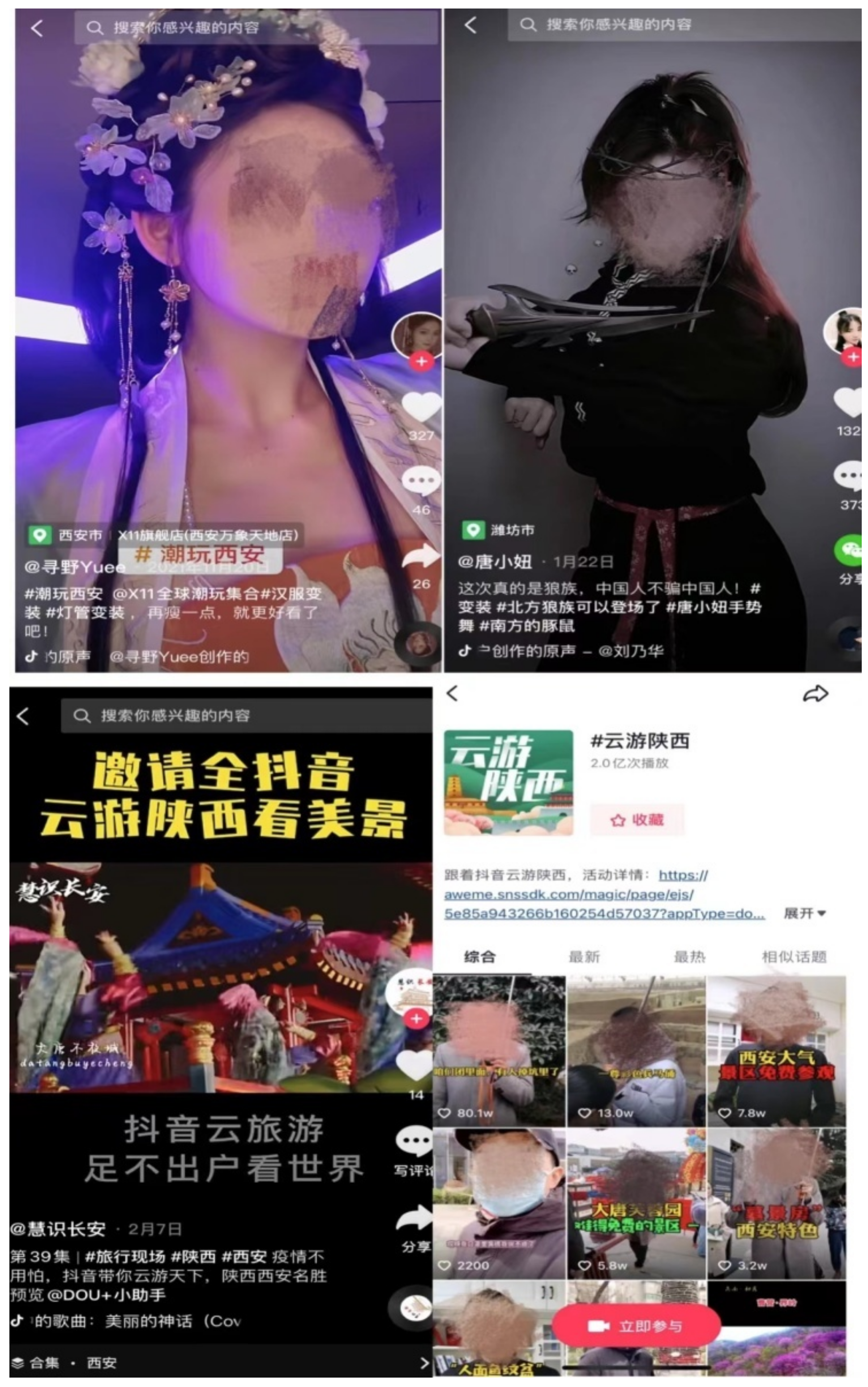Toward Tourists–Media–Cities Tourism: Xi’an as a Wanghong City
Abstract
1. Introduction
2. Literature Review: Toward an Innovative Framework of ToMeCi Tourism
3. Methods
4. Results
4.1. Clocking in and the Transformation of Xi’an
Traveling used to be all about seeing things and taking pictures. When I start clocking in and pinpoint my location on my phone, I feel like I know better where I am, and because the name of the place is familiar, I feel like that place is connected to me. (Interviewee L, December 2018)
When I post, I always choose something meaningful to post and then add a sentence or two to it. Like when I went to Datang Everbright City, I posted a video with “If you have not seen the Great Tang dynasty, come to Datang Everbright City, you will see!” (Interviewee N, December 2018)
As long as I clock in here and do not display the position data, others will know I am in Xi’an. Because the scenery and decoration here look very special, just like the feeling of Chang’an in the Tang Dynasty. (Interviewee V, May 2019)
Because here, many people will dress like this. I saw many people on the internet wearing Hanfu here. I was attracted by this atmosphere, so I chose Xi’an as the destination for this trip. I just wanted to see if it was like the video. Because Xi’an is an ancient capital, you can see that these streets look very classical, so there is nothing special about wearing these ancient costumes here, and the photos were taken better, the more likes I get. (Interviewee U, May 2019)
What comes to mind about Xi’an? Is it the majesty of the Terracotta Army, the morning bell and evening drum of the Bell and Drum Tower, the solemnity of the huge Wild Goose Pagoda, the cupping wine in Yongxing Square, or the local national dish Rou Jia Mo, Mutton Bubble Mo … ? Have you been to Xi’an before? What do you miss about food, scenery, or culture? If you are in Xi’an or currently traveling to the city, you may want to take in the city’s special features with TikTok and let us experience the new charm of this ancient cultural capital together.
4.2. Live Streaming and Consuming Xi’an
I like to watch the live stream of Datang Everbright City because there are so many retro shows. When I saw Feng Jiachen’s performance of the tumbler, I decided to go to that city in person. (Interviewee 2, December 2020)
I started live streaming soon after I came to Xi’an to study because Xi’an is a famous city on the Internet, so sometimes many people watch my live stream. I mainly explore the stores and visit some restaurants to live stream my taste test. Sometimes I talk about how this food tastes, where it comes from, and so on. Since I have more followers, I have been working with companies to promote their restaurants or their products. The best thing I ever did was selling chili oil sauce for a pasta store. I sold over 300 bottles in one hour. (Interviewee 12, September 2021)
I like to buy something local while watching live streams. It makes me feel like I am following someone else’s journey, but I can also try local food or buy local souvenirs. This way, I feel like I can somewhat satisfy my regret of not being able to travel offline. (Interviewee 5, April 2021)
I watched a lot of live streaming about Xi’an before this trip and felt like I was very familiar with this city. However, when I am here, I still want to turn on the live streaming and see what’s here. That way I can get to know the city better. I just went to a restaurant that is known to the locals and that I would not know if I were looking for it myself. (Interviewee 8, May 2021)
4.3. Cyberflaneurs in Xi’an during the COVID-19 Pandemic
I love to travel, but I have not traveled much since the COVID-19 outbreak. Because of the pandemic, it is very difficult to travel, and now it is convenient to travel online. I often watch short videos and live streamings about the tour. Surprisingly, I have even discovered things that I could not see when I was physically traveling before. (Interviewee 20, November 2021)
5. Discussion
6. Conclusions
Author Contributions
Funding
Informed Consent Statement
Data Availability Statement
Conflicts of Interest
References
- Zhang, Z. Infrastructuralization of Tik Tok: Transformation, Power Relationships, and Platformization of Video Entertainment in China. Media Cult. Soc. 2021, 43, 219–236. [Google Scholar] [CrossRef]
- Wang, Y.; Feng, D. History, Modernity, and City Branding in China: A Multimodal Critical Discourse Analysis of Xi’an’s Promotional Videos on Social Media. Soc. Semiot. 2021, 1–24. [Google Scholar] [CrossRef]
- Dickinson, J.E.; Filimonau, V.; Hibbert, J.F.; Cherrett, T.; Davies, N.; Norgate, S.; Speed, C.; Winstanley, C. Tourism Communities and Social Ties: The Role of Online and Offline Tourist Social Networks in Building Social Capital and Sustainable Practice. J. Sustain. Tour. 2017, 25, 163–180. [Google Scholar] [CrossRef]
- Choi, S.; Lehto, X.Y.; Morrison, A.M. Destination Image Representation on the Web: Content Analysis of Macau Travel Related Websites. Tour. Manag. 2007, 28, 118–129. [Google Scholar] [CrossRef]
- Hays, S.; Page, S.J.; Buhalis, D. Social Media as a Destination Marketing Tool: Its Use by National Tourism Organisations. Curr. Issues Tour. 2013, 16, 211–239. [Google Scholar] [CrossRef]
- Jacobsen, J.K.S.; Munar, A.M. Tourist Information Search and Destination Choice in a Digital Age. Tour. Manag. Perspect. 2012, 1, 39–47. [Google Scholar] [CrossRef]
- Zhou, L.; Wang, T. Social Media: A New Vehicle for City Marketing in China. Cities 2014, 37, 27–32. [Google Scholar] [CrossRef]
- Luo, Q.; Zhong, D. Using social network analysis to explain communication characteristics of travel-related electronic word-of-mouth on social networking sites. Tour. Manag. 2015, 46, 274–282. [Google Scholar] [CrossRef]
- Liu, X.; Mehraliyev, F.; Liu, C.; Schuckert, M. The roles of social media in tourists’ choices of travel components. Tour. Stud. 2020, 20, 27–48. [Google Scholar] [CrossRef]
- Shu, M.; Scott, N. Influence of Social Media on Chinese Students’ Choice of an Overseas Study Destination: An Information Adoption Model Perspective. J. Travel Tour. Mark. 2014, 31, 286–302. [Google Scholar] [CrossRef]
- Govers, R.; Go, F.M.; Kumar, K. Virtual destination image a new measurement approach. Ann. Tour. Res. 2007, 34, 977–997. [Google Scholar] [CrossRef]
- Berg, L.P.; Vance, J.M. Industry Use of Virtual Reality in Product Design and Manufacturing: A Survey. Virtual Real. 2017, 21, 1–17. [Google Scholar] [CrossRef]
- Kim, M.J.; Lee, C.-K.; Jung, T. Exploring Consumer Behavior in Virtual Reality Tourism Using an Extended Stimulus-Organism-Response Model. J. Travel Res. 2020, 59, 69–89. [Google Scholar] [CrossRef]
- Oncioiu, I.; Priescu, I. The Use of Virtual Reality in Tourism Destinations as a Tool to Develop Tourist Behavior Perspective. Sustainability 2022, 14, 4191. [Google Scholar] [CrossRef]
- Păcurar, C.M.; Albu, R.-G.; Păcurar, V.D. Tourist Route Optimization in the Context of Covid-19 Pandemic. Sustainability 2021, 13, 5492. [Google Scholar] [CrossRef]
- Škrinjarić, T. Ranking Environmental Aspects of Sustainable Tourism: Case of Selected European Countries. Sustainability 2021, 13, 5701. [Google Scholar] [CrossRef]
- Huang, S.; Shao, Y.; Zeng, Y.; Liu, X.; Li, Z. Impacts of COVID-19 on Chinese Nationals’ Tourism Preferences. Tour. Manag. Perspect. 2021, 40, 100895. [Google Scholar] [CrossRef]
- Yang, Y.; Ruan, Q.; Huang, S.; Lan, T.; Wang, Y. Impact of the COVID-19 Outbreak on Tourists’ Real-Time on-Site Emotional Experience in Reopened Tourism Destinations. J. Hosp. Tour. Manag. 2021, 48, 390–394. [Google Scholar] [CrossRef]
- Zhong, L.; Sun, S.; Law, R.; Deng, B. An investigation of international tourist flow modelling during the pandemic. Curr. Issues Tour. 2022, 25, 1910–1919. [Google Scholar] [CrossRef]
- Li, L.; Tao, Z.; Lu, L.; Liu, H.; Zhang, J.; Zhang, M. The impact of COVID-19 on the regional tourism flow network: An empirical study in Hubei Province. Curr. Issues Tour. 2022, 25, 287–302. [Google Scholar] [CrossRef]
- Akhtar, N.; Khan, N.; Mahroof Khan, M.; Ashraf, S.; Hashmi, M.S.; Khan, M.M.; Hishan, S.S. Post-COVID 19 Tourism: Will Digital Tourism Replace Mass Tourism? Sustainability 2021, 13, 5352. [Google Scholar] [CrossRef]
- Lu, J.; Xiao, X.; Xu, Z.; Wang, C.; Zhang, M.; Zhou, Y. The potential of virtual tourism in the recovery of tourism industry during the COVID-19 pandemic. Curr. Issues Tour. 2022, 25, 441–457. [Google Scholar] [CrossRef]
- Toubes, D.R.; Vila, N.A.; Fraiz Brea, J.F. Changes in Consumption Patterns and Tourist Promotion after the COVID-19 Pandemic. J. Theor. Appl. Electron. Commer. Res. 2021, 16, 1332–1352. [Google Scholar] [CrossRef]
- Xi’an Municipal Administration of Cultural and Tourism. Available online: http://wlj.xa.gov.cn/wlxw/wlzx/6160f5abf8fd1c0bdc579c10.html (accessed on 9 October 2021).
- Mckercher, B.; Lau, G. Movement Patterns of Tourists within a Destination. Tour. Geogr. 2008, 10, 355–374. [Google Scholar] [CrossRef]
- Mcquire, S. The Media City: Media, Architecture and Urban Space; Sage: Thousand Oaks, CA, USA, 2008; ISBN 9780857025371. [Google Scholar]
- Qiu, Q.; Zuo, Y.; Zhang, M. Can Live Streaming Save the Tourism Industry from a Pandemic? A Study of Social Media. ISPRS Int. J. Geo-Inf. 2021, 10, 595. [Google Scholar] [CrossRef]
- Sun, W. I photograph, therefore I am, we card-punch, therefore the city is Short video: The mass image practices of cyber cities. Chin. J. Journal. Commun. 2020, 6, 6–12. [Google Scholar] [CrossRef]
- Bouchon, F.; Rauscher, M. Cities and Tourism, a Love and Hate Story; towards a Conceptual Framework for Urban Overtourism Management. Int. J. Tour. Cities 2019, 5, 598–619. [Google Scholar] [CrossRef]
- Faulkner, B.; Tideswell, C. A framework for monitoring community impacts of tourism. J. Sustain. Tour. 1997, 5, 3–28. [Google Scholar] [CrossRef]
- Shi, C.; Liu, M.; Ye, Y. Measuring the Degree of Balance between Urban and Tourism Development: An Analytical Approach Using Cellular Data. Sustainability 2021, 13, 9598. [Google Scholar] [CrossRef]
- Rogerson, C.M.; Rogerson, J.M. City Tourism in South Africa: Diversity and Change. Tour. Rev. Int. 2017, 21, 193–211. [Google Scholar] [CrossRef]
- Huh, C.; Vogt, C.A. Changes in Residents’ Attitudes toward Tourism over Time: A Cohort Analytical Approach. J. Travel Res. 2008, 46, 446–455. [Google Scholar] [CrossRef]
- Schofield, P. City Resident Attitudes to Proposed Tourism Development and Its Impacts on the Community. Int. J. Tour. Res. 2011, 13, 218–233. [Google Scholar] [CrossRef]
- Snaith, T.; Haley, A. Residents’ Opinions of Tourism Development in the Historic City of York, England. Tour. Manag. 1999, 20, 595–603. [Google Scholar] [CrossRef]
- Lee, P.; Hunter, W.C.; Chung, N. Smart Tourism City: Developments and Transformations. Sustainability 2020, 12, 3958. [Google Scholar] [CrossRef]
- Lovell, J. Fairytale Authenticity: Historic City Tourism, Harry Potter, Medievalism and the Magical Gaze. J. Herit. Tour. 2019, 14, 448–465. [Google Scholar] [CrossRef]
- Richards, G. Creativity and Tourism in the City. Curr. Issues Tour. 2014, 17, 119–144. [Google Scholar] [CrossRef]
- Bock, K. The Changing Nature of City Tourism and Its Possible Implications for the Future of Cities. Eur. J. Future Res. 2015, 3, 20. [Google Scholar] [CrossRef]
- Adeola, O.; Evans, O. Digital Tourism: Mobile Phones, Internet and Tourism in Africa. Tour. Recreat. Res. 2019, 44, 190–202. [Google Scholar] [CrossRef]
- Tussyadiah, I.P.; Wang, D.; Jung, T.H.; tom Dieck, M.C. Virtual Reality, Presence, and Attitude Change: Empirical Evidence from Tourism. Tour. Manag. 2018, 66, 140–154. [Google Scholar] [CrossRef]
- Decrop, A. The Influence of Message Format on the Effectiveness of Print Advertisements for Tourism Destinations. Int. J. Advert. 2007, 26, 505–525. [Google Scholar] [CrossRef]
- Hou, Z. Comparison Study of Advertising Videos of Tourism City Image-Based on the Content Analysis Method. EURASIA J. Math. Sci. Technol. Educ. 2017, 13, 6737–6746. [Google Scholar] [CrossRef]
- Liao, Z.; Shi, X. Web Functionality, Web Content, Information Security, and Online Tourism Service Continuance. J. Retail. Consum. Serv. 2017, 39, 258–263. [Google Scholar] [CrossRef]
- Edwards, D.; Griffin, T. Understanding Tourists’ Spatial Behaviour: GPS Tracking as an Aid to Sustainable Destination Management. J. Sustain. Tour. 2013, 21, 580–595. [Google Scholar] [CrossRef]
- Suhartanto, D.; Dean, D.; Semiawan, T.; Kusdibyo, L.; Sobarna, A. Cognizing Tourist Loyalty during Covid-19 Pandemic through Virtual Reality Lens. Tour. Recreat. Res. 2021, 1–13. [Google Scholar] [CrossRef]
- Ramos, C.M.Q.; Rodrigues, P.M.M. Research Note: The Importance of Online Tourism Demand. Tour. Econ. 2013, 19, 1443–1447. [Google Scholar] [CrossRef]
- Khan, N.; Qureshi, M.I. A Systematic Literature Review on Online Medical Services in Malaysia. Int. J. Online Biomed. Eng. (IJOE) 2020, 16, 107. [Google Scholar] [CrossRef]
- Wang, J.; Wang, Y.; He, Y.C.; Zhu, Z.X. Exploring the Factors of Rural Tourism Recovery in the Post-COVID-19 Era Based on the Grounded Theory: A Case Study of Tianxi Village in Hunan Province, China. Sustainability 2022, 14, 5215. [Google Scholar] [CrossRef]
- Fast, K.; Ljungberg, E.; Braunerhielm, L. On the Social Construction of Geomedia Technologies. Commun. Public 2019, 4, 89–99. [Google Scholar] [CrossRef]
- Kittler, F.A.; Griffin, M. The City Is a Medium. New Lit. Hist. 1996, 27, 4. [Google Scholar]
- Barns, S.; Cosgrave, E.; Acuto, M.; Mcneill, D. Digital Infrastructures and Urban Governance. Urban Policy Res. 2016, 35, 20–31. [Google Scholar] [CrossRef]
- Jansson, A. Rethinking Post-Tourism in the Age of Social Media. Ann. Tour. Res. 2018, 69, 101–110. [Google Scholar] [CrossRef]
- Centner, R. Places of Privileged Consumption Practices: Spatial Capital, the Dot–Com Habitus, and San Francisco’s Internet Boom. City Commu. 2008, 7, 193–223. [Google Scholar] [CrossRef]
- Krajina, Z. Negotiating the Mediated City: Everyday Encounters with Public Screens; Routledge: New York, NY, USA, 2013; ISBN 9781138400320. [Google Scholar]
- Wearing, S.; Schweinsberg, S.; Johnson, P. Flâneur or Choraster: A Review of the Travel Narrator In the Formation of the Tourist Experience. Tour. Anal. 2019, 24, 551–562. [Google Scholar] [CrossRef]
- Benckendorff, P.; Sheldon, P.; Fesenmaier, D. Tourism Information Technology, 2nd ed.; CABI: Wallingford, UK, 2014; ISBN 9781786393432. [Google Scholar]
- Dick, B.F.; Eco, U.; Weaver, W. Travels in Hyperreality. Picador 1987, 61, 168. [Google Scholar] [CrossRef]
- Jules-Rosette, B. Black Paris. Ann. Tour. Res. 1994, 21, 679–700. [Google Scholar] [CrossRef]
- Xiang, Z.; Gretzel, U. Role of Social Media in Online Travel Information Search. Tour. Manag. 2010, 31, 179–188. [Google Scholar] [CrossRef]
- Fatanti, M.N.; Suyadnya, I.W. Beyond User Gaze: How Instagram Creates Tourism Destination Brand? Procedia-Soc. Behav. Sci. 2015, 211, 1089–1095. [Google Scholar] [CrossRef]
- Hunter, W.C. The Social Construction of Tourism Online Destination Image: A Comparative Semiotic Analysis of the Visual Representation of Seoul. Tour. Manag. 2016, 54, 221–229. [Google Scholar] [CrossRef]
- Villa, L.M.O.; Fierros, H.E.M.; Marín, M.O. Representaciones mediáticas del clima como antihéroe en relatos de dos diarios. Mediac. Soc. 2021, 20, e77522. [Google Scholar] [CrossRef]
- de Waal, M. The City as Interface: How New Media Are Changing the City; Nai010 Publishers: Rotterdam, The Netherlands, 2014; ISBN 9789462080508. [Google Scholar]
- Svitich, L.G.; Smirnova, O.; Shiryayeva, A.; Shkondin, M. Thematic Model of City Newspapers of Megalopolises (Content-Analytical Study). Theor. Pract. Issues Journal. 2018, 7, 371–393. [Google Scholar] [CrossRef]
- Matthews, J. The Role of a Local Newspaper after Disaster: An Intrinsic Case Study of Ishinomaki, Japan. Asian J. Commun. 2017, 27, 464–479. [Google Scholar] [CrossRef]
- Ma, J.X.; Buhalis, D.; Song, H. ICTs and Internet Adoption in China’s Tourism Industry. Int. J. Inf. Manag. 2003, 23, 451–467. [Google Scholar] [CrossRef]
- Ivars-Baidal, J.A.; Celdrán-Bernabeu, M.A.; Mazón, J.-N.; Perles-Ivars, Á.F. Smart Destinations and the Evolution of ICTs: A New Scenario for Destination Management? Curr. Issues Tour. 2019, 22, 1581–1600. [Google Scholar] [CrossRef]
- Adonina, A.; Akhmedova, E.; Kandalova, A. Realization of Smart City Concept through Media Technology in Architecture and Urban Space: From Utopia to Reality. MATEC Web Conf. 2018, 170, 02013. [Google Scholar] [CrossRef][Green Version]
- Navío-Marco, J.; Ruiz-Gómez, L.M.; Sevilla-Sevilla, C. Progress in Information Technology and Tourism Management: 30 Years on and 20 Years after the Internet-Revisiting Buhalis & Law’s Landmark Study about ETourism. Tour. Manag. 2018, 69, 460–470. [Google Scholar] [CrossRef]
- Zhou, C.; Sotiriadis, M. Exploring and Evaluating the Impact of ICTs on Culture and Tourism Industries’ Convergence: Evidence from China. Sustainability 2021, 13, 11769. [Google Scholar] [CrossRef]
- Law, R.; Chan, I.C.C.; Wang, L. A Comprehensive Review of Mobile Technology Use in Hospitality and Tourism. J. Hosp. Mark. Manag. 2018, 27, 626–648. [Google Scholar] [CrossRef]
- Jamal, S.; Habib, M.A. Smartphone and Daily Travel: How the Use of Smartphone Applications Affect Travel Decisions. Sustain. Cities Soc. 2020, 53, 101939. [Google Scholar] [CrossRef]
- Wang, D.; Park, S.; Fesenmaier, D.R. The Role of Smartphones in Mediating the Touristic Experience. J. Travel Res. 2012, 51, 371–387. [Google Scholar] [CrossRef]
- Okazaki, S.; Campo, S.; Andreu, L.; Romero, J. A Latent Class Analysis of Spanish Travelers’ Mobile Internet Usage in Travel Planning and Execution. Cornell Hosp. Q. 2015, 56, 191–201. [Google Scholar] [CrossRef]
- Abrams, L.S. Sampling “hard to reach” populations in qualitative research: The case of incarcerated youth. Qual. Soc. Work 2010, 9, 536–550. [Google Scholar] [CrossRef]
- Lindlof, T.R.; Taylor, B.C. Qualitative Communication Research Methods, 3rd ed.; Sage: Thousand Oaks, CA, USA, 2011; ISBN 9781412974738. [Google Scholar]
- Schwandt, T.A. Qualitative Inquiry: A Dictionary of Terms; Sage: Thousand Oaks, CA, USA, 1997; p. 128. ISBN 978-0761902539. [Google Scholar]
- Leung, D.; Law, R.; van Hoof, H.; Buhalis, D. Social Media in Tourism and Hospitality: A Literature Review. J. Travel Tour. Mark. 2013, 30, 3–22. [Google Scholar] [CrossRef]
- Garrod, B. Understanding the Relationship between Tourism Destination Imagery and Tourist Photography. J. Travel Res. 2009, 47, 346–358. [Google Scholar] [CrossRef]
- Buhalis, D.; Foerste, M. SoCoMo Marketing for Travel and Tourism: Empowering Co-Creation of Value. J. Destin. Mark. Manag. 2015, 4, 151–161. [Google Scholar] [CrossRef]
- Lee, M.K.; Yoon, H.Y.; Park, H.W. From Online via Offline to Online: How Online Visibility of Tourism Information Shapes and Is Shaped by Offline Visits. J. Travel Tour. Mark. 2017, 34, 1143–1154. [Google Scholar] [CrossRef]
- Vissers, S.; Stolle, D. Spill-Over Effects Between Facebook and On/Offline Political Participation? Evidence from a Two-Wave Panel Study. J. Inf. Technol. Polit. 2014, 11, 259–275. [Google Scholar] [CrossRef]
- Cunningham, S.; Craig, D.; Lv, J. China’s Livestreaming Industry: Platforms, Politics, and Precarity. Int. J. Cult. Stud. 2019, 22, 719–736. [Google Scholar] [CrossRef]
- Han, X. Historicising Wanghong Economy: Connecting Platforms through Wanghong and Wanghong Incubators. Celebr. Stud. 2021, 12, 317–325. [Google Scholar] [CrossRef]
- Ruhnn Semi-Annual Report 2017. Ruhnn Holdings. Available online: https://Semi-Annual-Report-2017.pdf (accessed on 12 January 2022).
- Simon, B. Beyond Cyberspatial Flaneurie: On the Analytic Potential of Living With Digital Games. Games Cult. 2006, 1, 62–67. [Google Scholar] [CrossRef]
- Benjamin, W. Charles Baudelaire: A Lyric Poet in the Era of High Capitalism; Verso: London, UK, 1997; ISBN 9781859841921. [Google Scholar]
- Book, B. Traveling through Cyberspace: Tourism and Photography in Virtual Worlds. Soc. Sci. Electron. Publ. 2003. [CrossRef]
- Gössling, S.; Scott, D.; Hall, C.M. Pandemics, Tourism and Global Change: A Rapid Assessment of COVID-19. J. Sustain. Tour. 2021, 29, 1–20. [Google Scholar] [CrossRef]
- Urry, J. Consuming Places; Routledge: London, UK, 1995; ISBN 978-0415113113. [Google Scholar]
- Tan, G.W.-H.; Lee, V.H.; Lin, B.; Ooi, K.-B. Mobile Applications in Tourism: The Future of the Tourism Industry? Ind. Manag. Data Syst. 2017, 117, 560–581. [Google Scholar] [CrossRef]
- Richards, G. Cultural Tourism: A Review of Recent Research and Trends. J. Hosp. Tour. Manag. 2018, 36, 12–21. [Google Scholar] [CrossRef]
- Livingstone, S. On the mediation of everything: ICA presidential address 2008. J. Commun. 2009, 59, 1–18. [Google Scholar] [CrossRef]




| Period 1 (December 2017 to May 2019) | Period 2 (December 2020 to December 2021) | ||
|---|---|---|---|
| Interviewee Code | Personal Information (Gender/Age/Job) | Interviewee Code | Personal Information (Gender/Age/Job) |
| A | F/20/College student | 1 | F/37/Teacher |
| B | F/25/Clerk | 2 | M/28/— |
| C | F/54/Nurse | 3 | M/28/Salesman |
| D | M/35/Taxi driver | 4 | F/37/— |
| E | M/25/College student | 5 | F/23/College student |
| F | F/25/— | 6 | M/33/Taxi driver |
| G | F/27/Master’s student | 7 | M/—/Taxi driver |
| H | M/26/Master’s student | 8 | M/29/Clerk |
| I | M/55/Professor | 9 | M/26/Courier |
| J | F/38/Teacher | 10 | F/37/Courier |
| K | M/37/Courier | 11 | F/19/Student |
| L | M/37/— | 12 | F/24/College student |
| M | F/25/— | 13 | F/31/— |
| N | M/32/Teacher | 14 | F/35/— |
| O | F/35/Teacher–student | 15 | F/25/Master’s student |
| P | M/45/Restaurant owner | 16 | F/24/Master’s student |
| Q | M/24/Restaurant waiter | 17 | M/24/Master’s student |
| R | M/26/Clerk | 18 | M/30/Teacher |
| S | M/24/Student | 19 | M/34/Teacher |
| T | F/14/Student | 20 | F/35/Teacher |
| U | F/17/Student | 21 | F/—/Clerk |
| V | F/22/College student | 22 | M/16/Student |
| 23 | M/17/Student | ||
| 24 | M/—/College student | ||
| 25 | F/30/Clerk | ||
| 26 | F/38/Teacher | ||
Publisher’s Note: MDPI stays neutral with regard to jurisdictional claims in published maps and institutional affiliations. |
© 2022 by the authors. Licensee MDPI, Basel, Switzerland. This article is an open access article distributed under the terms and conditions of the Creative Commons Attribution (CC BY) license (https://creativecommons.org/licenses/by/4.0/).
Share and Cite
Fan, T.; Lin, Z. Toward Tourists–Media–Cities Tourism: Xi’an as a Wanghong City. Sustainability 2022, 14, 11806. https://doi.org/10.3390/su141911806
Fan T, Lin Z. Toward Tourists–Media–Cities Tourism: Xi’an as a Wanghong City. Sustainability. 2022; 14(19):11806. https://doi.org/10.3390/su141911806
Chicago/Turabian StyleFan, Tingting, and Zhongxuan Lin. 2022. "Toward Tourists–Media–Cities Tourism: Xi’an as a Wanghong City" Sustainability 14, no. 19: 11806. https://doi.org/10.3390/su141911806
APA StyleFan, T., & Lin, Z. (2022). Toward Tourists–Media–Cities Tourism: Xi’an as a Wanghong City. Sustainability, 14(19), 11806. https://doi.org/10.3390/su141911806





